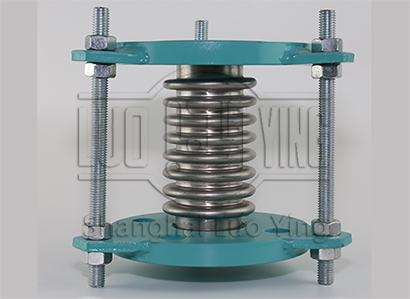Construction setting method of axial internal pressure compound corrugated expansion joint.
Jul-23-14
Construction setting method of axial internal pressure compound corrugated expansion joint. The construction setting method of axial internal pressure compound corrugated expansion joint involves several important steps to ensure its proper installation. Here is a detailed guide on how to set up this type of expansion joint properly:
1 . Preparation: Before starting the installation process, gather all the necessary tools, equipment, and materials. Ensure that you have the appropriate sizes and types of expansion joint components, such as the corrugated bellows, flange connectors, and tie rods.
2 . Inspection and Measurement: Inspect all the expansion joint components for any defects or damage before installation. Measure the dimensions of the piping system and expansion joint to ensure a proper fit. Check the axial and lateral movement requirements specified by the project engineer or manufacturer.
3 . Cleaning and Surface Preparation: Thoroughly clean the mating faces of the flanges and the bellows to remove any dirt, debris, or grease. Use an appropriate solvent or cleaning agent to ensure proper adhesion. Smooth out any rough spots or burrs on the flange surfaces to prevent leakage or damage to the bellows.

5 . Bolting and Tightening: Attach the flange connectors to the pipe flanges using the appropriate bolts, nuts, and gaskets. Follow the recommended tightening sequence and torque values provided by the manufacturer. Ensure that the bolts are evenly tightened to create a uniform seal and prevent leaks.
6 . Installation of Tie Rods: If applicable, install the tie rods to provide additional support and stability to the expansion joint. Attach the rods to the flange connectors and secure them tightly, but avoid over-tightening. Follow the manufacturer's instructions for the proper placement and tensioning of the tie rods.
7 . Testing: After the installation is complete, conduct a pressure test to verify the integrity of the expansion joint. Apply the internal pressure specified by the project engineer gradually and monitor for any signs of leaks or deformations. Perform a visual inspection and use non-destructive testing techniques, if necessary, to ensure the joint's performance meets the required standards.
8 . Documentation: Keep detailed records of the installation process, including measurements, test results, and any deviations or adjustments made. Label the expansion joint with relevant information, such as its size, type, and installation date. Maintain these records for future reference and maintenance purposes.
It is important to consult the manufacturer's guidelines and specifications for the specific axial internal pressure compound corrugated expansion joint being installed. Following these construction setting methods will help ensure a proper and efficient installation, allowing the expansion joint to function effectively in accommodating axial movements and maintaining the integrity of the piping system.

